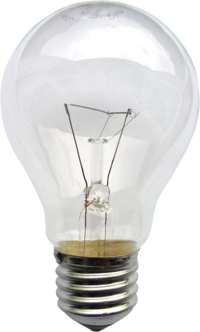
Photo from wikipedia
For high-power white LED applications, YAG:Ce-based yellow phosphors were embedded in a low-Tg Bi2O3–B2O5–ZnO–Sb2O5 glass by sintering route. Effects of sintering temperature (325-390°C) on the microstructure and photoluminescence properties were… Click to show full abstract
For high-power white LED applications, YAG:Ce-based yellow phosphors were embedded in a low-Tg Bi2O3–B2O5–ZnO–Sb2O5 glass by sintering route. Effects of sintering temperature (325-390°C) on the microstructure and photoluminescence properties were investigated. X-ray diffraction was used to measure the retained fraction of YAG:Ce phase after sintering. Scanning electron microscope and transmission electron microscope, equipped with energy-dispersive X-ray spectrometry, were used to examine the microstructure, including the element distribution across the phosphor–glass interface. Photoluminescence properties of the samples before and after sintering were compared. With the increasing sintering temperature, the retained fraction of YAG:Ce decreased from 83.3% to 82%. This effect tends to reduce the luminescence intensity of the samples after sintering. The increasing sintering temperature also enhances the diffusion of cations (esp. Bi) from glass matrix to YAG:Ce. This effect tends to increase the luminescence intensity of the YAG:Ce particles after sintering. When the sintering temperature was lower (325°C), the effect of YAG:Ce loss was dominant, thus the luminescence intensity was reduced after sintering. When the sintering temperature was higher (350-390°C), the effect of solute dissolution was dominant, resulting in luminescence intensity anomalously higher than that before sintering. Similar result has not been reported in literatures. The maximum luminescence intensity of the sintered samples is 1.57 times as high as that of the samples before sintering.
Journal Title: Journal of the American Ceramic Society
Year Published: 2017
Link to full text (if available)
Share on Social Media: Sign Up to like & get
recommendations!